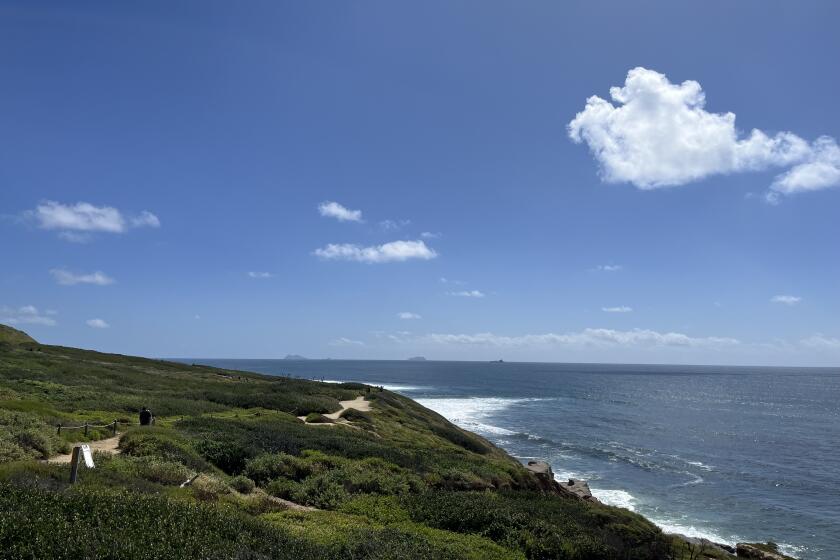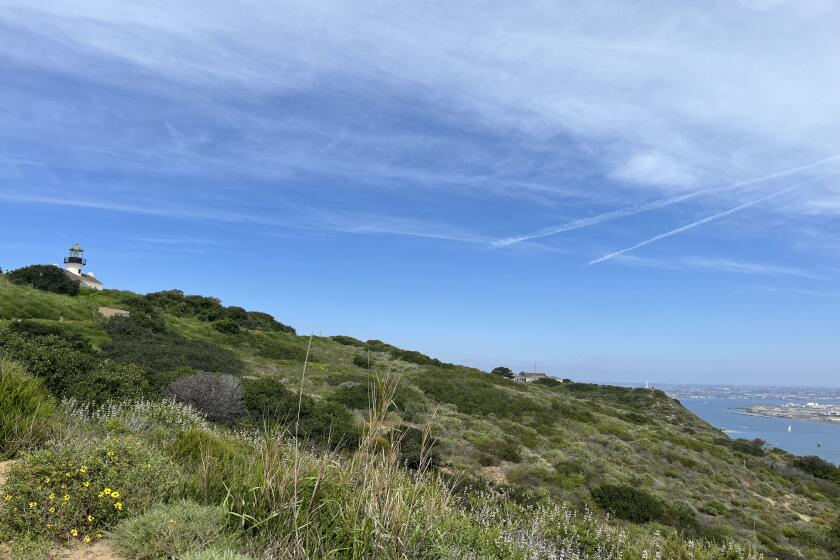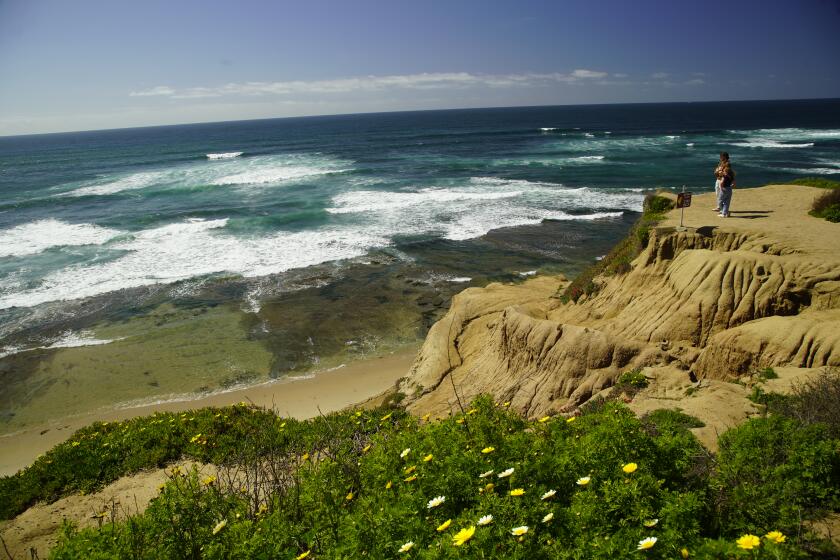The big hook-up: Sportfishing’s superb season
This summer, there is a certain swagger to the anglers disembarking from the swarm of sportfishing boats returning daily to San Diego’s docks.
With grins on their faces and images of wide-open bites in their heads, they stand, relaxed and tired, as they wait for deck hands to wheel up big carts filled with tuna and dorado caught during one of the most rewarding two-year fishing runs in recent memory.
While this scene is most common in San Diego, the epicenter of Southern California sportfishing, it is appearing far up the coast as an unprecedented pattern of warm ocean currents lures migratory tuna and other tropical species deep into U.S. waters.
“You can catch tuna from eight to 50 miles offshore. Normally, 60 to 100 miles offshore is typical,” said Ken Franke, president of the Sportfishing Association of California. “Right now, the fleet is spread the entire length of the coast. From Baja up as far as the Channel Islands, we’re seeing anglers catching bluefin and yellowfin tuna. It’s an amazing time to be out on the ocean.”
In San Diego, home to Southern California’s biggest sportfishing fleet, boats large and small have seen brisk business all summer for voyages lasting from a few hours to a few weeks.
Fishing has always been as much about the storytelling as it is about the catching, and there were plenty of excited retellings floating around H&M Landing in Point Loma one evening last week.
After filling a hefty cooler with football-sized yellowfin tuna and larger dorado, Michael Martino of Vista said his two-day excursion on the 75-foot boat Legend had plenty of excitement.
“There were about three stops we made where the bite was wide-open crazy, everybody yelling for the gaff,” Martino said, referring to the sharp pole-mounted hook that deck hands use to pull large fish onto the deck once they are reeled to the boat.
This was not his first successful outing.
“Last year I went on a lot of trips as well. This year, I’d say, the fish are bigger, but last year we were getting more quantity,” Martino said.
Along the dock, just-returned anglers hustled to claim their catches and buy enough ice to protect them from spoiling on the trip home.
The return trip would be farther for some than others.
Tim Hayes and his 13-year-old son, Jeremy, from Laguna Beach stood proudly over a cooler topped with two very long dorado, a wedge-shaped species known for jumping out of the water when hooked.
Father and son took an overnighter aboard the Grande out of Point Loma Sportfishing. It was Jeremy’s first serious deep-sea fishing trip, and he managed to participate in a haul that included 115 yellowfin and 46 dorado.
“It was just a great father-son experience,” Tim Hayes said. “All summer long he had been asking for this trip and we decided, when we kept seeing the fish reports, that we needed to get down to San Diego and get it in before Labor Day.”
Warm waters
Huge schools of muscular, torpedo-shaped tuna migrate hundreds of miles throughout the Pacific searching for food where the water is warm.
For about two years now, an atmospheric ridge of high pressure in the northeastern Pacific has blocked out storms and high winds, allowing the sun to heat a 2,000-mile stretch of ocean stretching from the Gulf of Alaska to Mexico. Weather experts call this huge patch of water, which is two to four degrees warmer than normal, “the blob.”
Meanwhile, a strong El Niño effect, which occurs when trade winds die down around the equator and allow ocean temperatures to rise, has reinforced the warm-water trend. So has a broader, 10-year warming and cooling pattern called the Pacific Decadal Oscillation.
These three climate phenomena have produced the uniquely long-lasting surge in water temperature that is attracting tuna and other fish much closer to shore — and much farther north than they would normally swim, said Toby Garfield, director of the environmental research division at the National Oceanic and Atmospheric Administration’s Southwest Fisheries Science Center in La Jolla.
“It’s warmer than we have ever recorded before. It’s like four standard deviations above the norm,” Garfield said.
The big question, he added, is what the predicted El Niño-driven storms will do to the high-pressure ridge that has resulted in dry winters and worsened California’s already-dire drought.
“What we suspect is going to happen is that the ridge is going to break down and the blob is going to cool. We may see a return to neutral conditions and much wetter weather from California into Texas,” Garfield said.
Climate experts believe the warm waters will likely stick around into the fall, meaning the prized fish might also stick around.
Good for business
Spots on charter boats in Southern California have been filling up quickly this summer. Prices range from about $50 for a half-day trip to $250 for an overnight excursion. Booking fees usually don’t cover the cost of a fishing license or rod rental, for those who don’t bring their own.
Those costs do not appear to be holding back many anglers.
Frank Ursitti, general manager of H&M Landing, said people are drawn by the possibility of leviathans below the sea surface. In some cases, he noted, tuna weighing more than 100 pounds have been caught on ¾ or one-day trips about 20 miles off the coast.
“In an average year, an angler would be looking at a five-day trip to get into triple-digit tuna,” he said.
Franke, the sportfishing association president, said the warm waters are also bringing fish like wahoo into U.S. waters. At least it did so in late summer and early fall last year, and many think the species, which is prized for its spectacular fight and pleasing flavor, will re-emerge off California’s coast this year.
Typically, boats need to travel south about 200 miles to get a chance at wahoo, Franke said.
“It would be the catch of a lifetime to get a wahoo in California waters, and it was happening last year,” he added.
Although Franke and Ursitti declined to give specific revenue figures, they said the warm waters have been kind to the sportfishing industry’s bottom line.
“I will say that we’ve just had the perfect storm of good things lately,” Franke said.
Fishing during the past two years has been about 300 percent better than it was five years ago, Ursitti said. “Our business is all driven by ocean conditions, and those conditions have been very favorable,” he added.
Impact on fisheries
The abundance arriving daily on Southern California docks comes against a backdrop of environmental concern.
A 2014 stock assessment of bluefin tuna showed that the species’ numbers have dwindled to only 4 percent of historical highs.
But Brice Semmens, an assistant professor in the marine biology research division at the Scripps Institution of Oceanography in La Jolla, said sportfishing generally does not affect populations of wild fish nearly as much as commercial fishing.
“If we take a step back and look at the long-term trend data, the impact of recreational fishing in California, compared to commercial fishing, they’re not even in the same ballpark,” Semmens said.
He added that the current focus on species such as tuna and dorado can also take pressure off of bottom-dwelling species like kelp bass, which are much more sensitive to overfishing caused by sportfishing.
“These fish live in our kelp forests, and kelp does not grow as well in warm water. So the current focus on migratory fish is, in essence, giving a pretty darn good break to the near-shore populations,” Semmens said.
Get Essential San Diego, weekday mornings
Get top headlines from the Union-Tribune in your inbox weekday mornings, including top news, local, sports, business, entertainment and opinion.
You may occasionally receive promotional content from the San Diego Union-Tribune.












